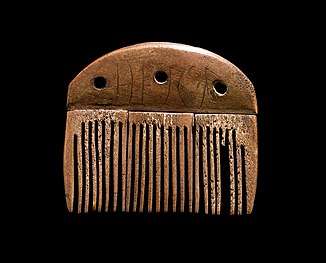Vimose inscriptions
Finds from Vimose, on the island of Funen, Denmark, include some of the oldest datable Elder Futhark runic inscriptions in early Proto-Norse or late Proto-Germanic from the 2nd to 3rd century in the Scandinavian Iron Age and were written in the time of the Roman Empire.
- Vimose Comb (c. 160, considered the oldest known datable runic inscription altogether): harja (ᚺᚨᚱᛃᚨ)[1]
- Vimose Buckle (c. 200) aadagasu =? ansuz-a(n)dag-a(n)su / laasauwija =? la-a[n]sau-wija;[2]
- Vimose Chape (c. 250): mariha || [.]ala / makija; possibly "Mari (the famous one) is the sword of Alla"[3]
- Vimose Woodplane (c. 300) talijo gisai oj: wiliz [..]la o[...] / tkbis: hleuno: an[.]: regu[4]
- Vimose Sheathplate (c. 300): awgns; possibly "son/descendant of Awa"[5]
- Vimose Spearhead: [w]agni[ŋ]o[6]

The Vimose Comb is housed at the National Museum of Denmark.
See also
References
- "Deutungen zu einer Inschrift". www.runenprojekt.uni-kiel.de.
- "Deutungen zu einer Inschrift". www.runenprojekt.uni-kiel.de.
- "Deutungen zu einer Inschrift". www.runenprojekt.uni-kiel.de.
- "Deutungen zu einer Inschrift". www.runenprojekt.uni-kiel.de.
- "Deutungen zu einer Inschrift". www.runenprojekt.uni-kiel.de.
- "Deutungen zu einer Inschrift". www.runenprojekt.uni-kiel.de.
- Seebold, Elmar (1994). "Die sprachliche Deutung und Einordnung der archaischen Runeninschriften". In Düwel, Klaus; Neumann, Hannelore; et al. (eds.). Runische Schriftkultur in Kontinental-Skandinavischer und -Angelsächsischer Wechselbeziehung. Walter de Gruyter. pp. 56–94. ISBN 3-11-014328-3.
This article is issued from Wikipedia. The text is licensed under Creative Commons - Attribution - Sharealike. Additional terms may apply for the media files.